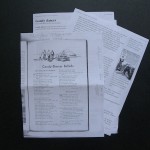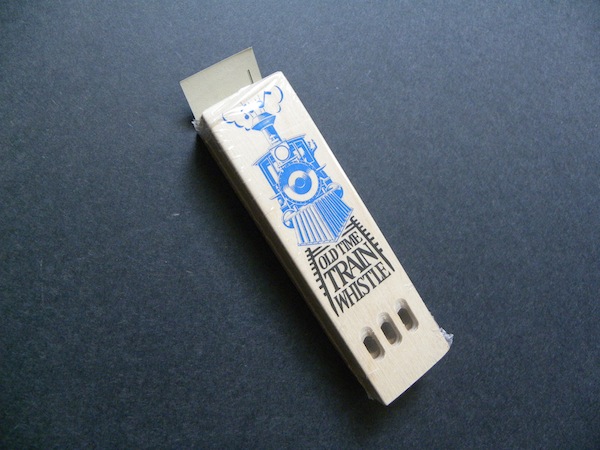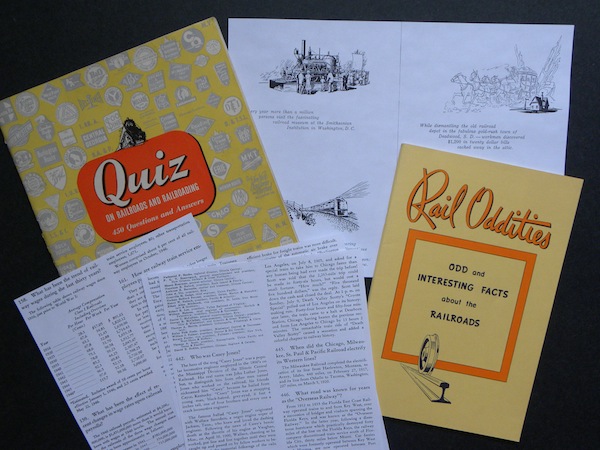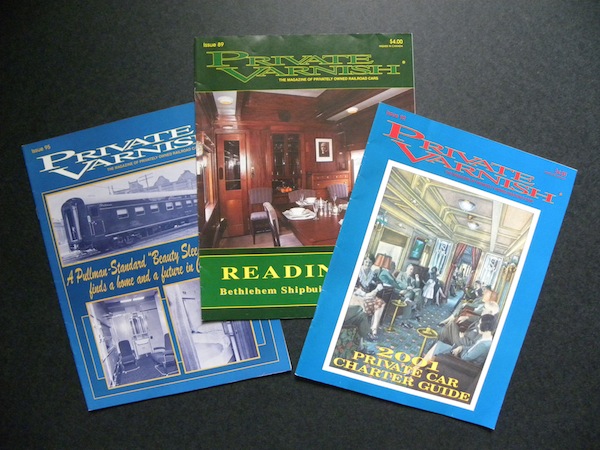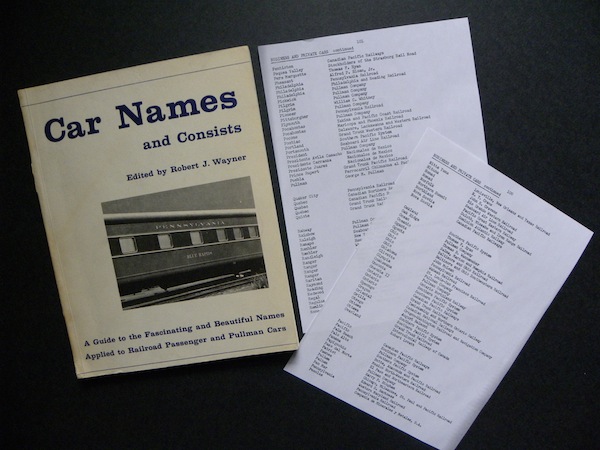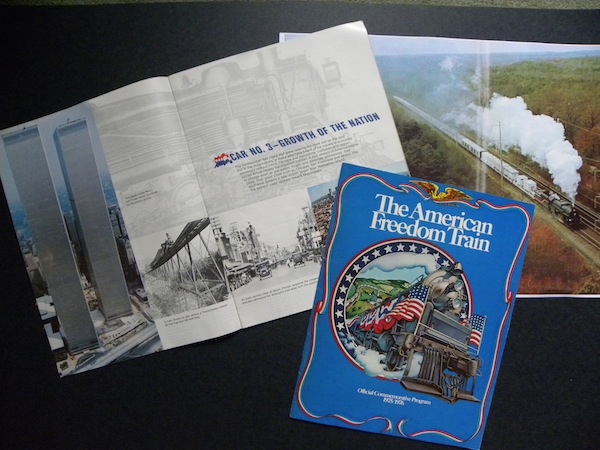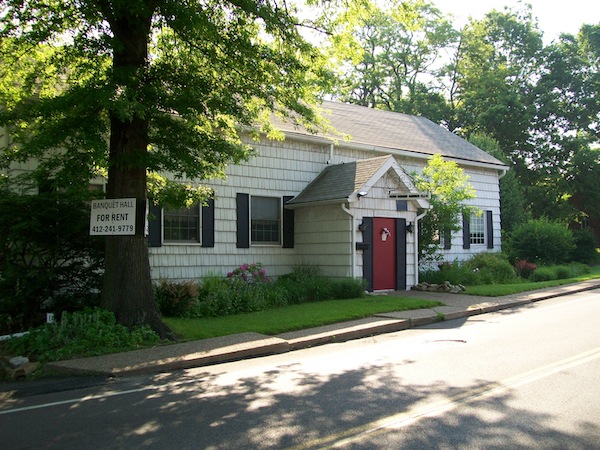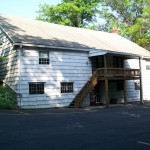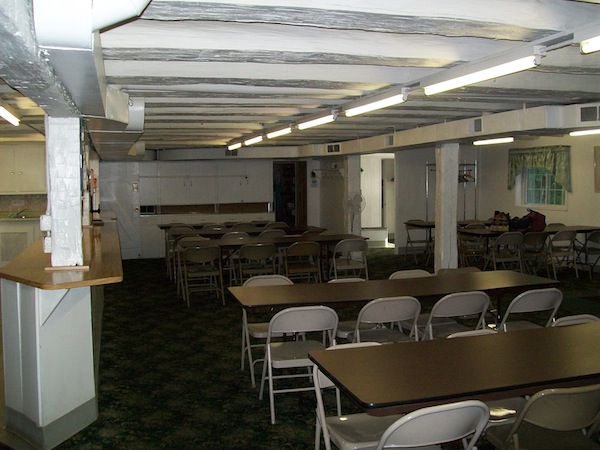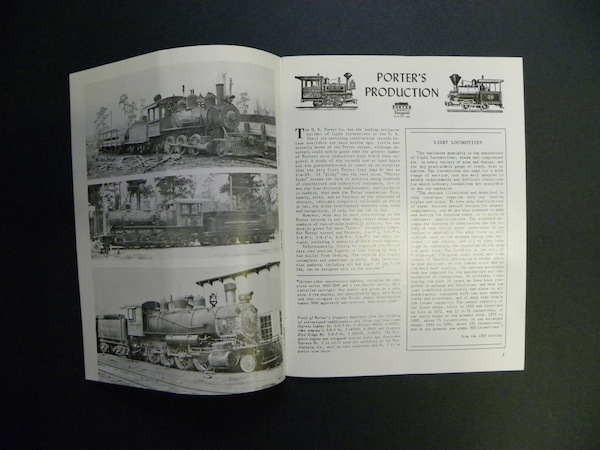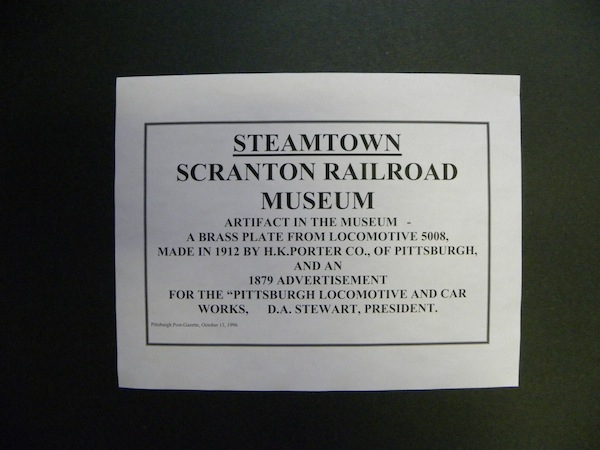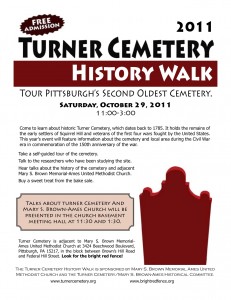
Category Archive: Preservation News
-
Leading the World in Preservation
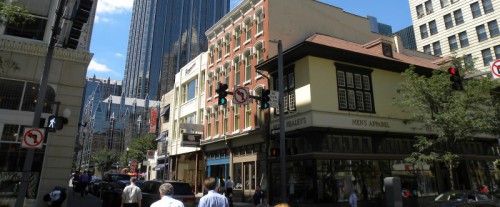
PHLF’s Market at Fifth featured as a major preservation achievement
PITTSBURGH, PA (Aug. 5, 2015) Pittsburgh has been named one of the 11 best and most livable cities in the world because of historic preservation according to Metropolis, a national magazine, which deals with “architecture and design at all scales.”
The magazine, which featured Pittsburgh in its July/August 2015 issue, selected Pittsburgh among a group of other cities including Toronto, Tokyo, Copenhagen, and Singapore, among others, which were selected for distinction in other areas ranging from walkability to culture, transportation planning, and landscapes.
“This is a great recognition for our city, which is showing the world that through adaptive reuse of our historic buildings, historic preservation is an underlying basis for social, human, and economic renewal,” said Mayor William Peduto.
Citing the decades-long efforts of preservationists, neighborhood activists, and specifically the work of the Pittsburgh History & Landmarks Foundation in battling the failed policies of urban renewal, the magazine noted that, “Pittsburgh, like so many other Rust Belt cities, faced huge hurdles with the decline of its steel industry. But it is overcoming many of these challenges thanks, in great part, to its preservation movements, neighborhood renewal projects, and active communities.”
“To have our City compared to others around the globe and be listed because of what we have achieved in preservation is an incredible distinction and honors the work of many citizens and organizations,” PHLF President Arthur Ziegler, said. “Our organization is especially honored to receive this recognition as we celebrate 50 years of our work in neighborhoods and communities across the region.”
The magazine featured PHLF’s Market at Fifth development in Downtown Pittsburgh, which combined quality retail and market-rate apartments in a LEED-Gold development, to highlight the ways in which the preservation community prevented “the demolition of 64 historic buildings in the core Downtown business area.”
In May, Mayor Peduto announced the completion of the restoration of 11 facades on 10 significant historic buildings in Downtown as part of the City’s ongoing revitalization of its core business district through historic preservation principles.
The buildings’ facades were restored by PHLF through a Redevelopment Assistance Capital Program grant from the Commonwealth of Pennsylvania awarded to the City through its Urban Redevelopment Authority.
-
Fairbanks Feature: A New Train of Thought––On the Lighter Side
James D. Van Trump Library | Frank B. Fairbanks Transportation Archive | Fairbanks Features
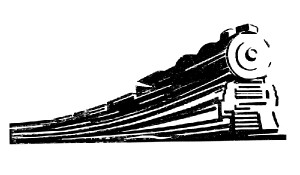 Showcasing a variety of materials located in the Frank B. Fairbanks Rail Transportation Archive
Showcasing a variety of materials located in the Frank B. Fairbanks Rail Transportation ArchiveNo. 14 Presentation
Fairbanks Feature: A New Train of Thought—On the Lighter Side
Most of the information in the Fairbanks Archive is in straight, printed text form. However, a small selection of material is presented in the form of questions and answers––or even poetry, song, and humor. In most cases, these presentations are not used by the serious researcher, but there is merit in perusing these forms, especially in recalling the days when railroads were one of the most important industries in our country.
The “quiz” booklets are full of information about the railroad industry at its peak. After seeing how valuable, efficient, and practical railroads were for people in their daily lives, one really wishes to bring back this wonderful era of transportation. Most of the booklets shown below were printed in the 1940s and early 1950s. Reading through the pages, nostalgia and respect for this time period comes through loud and clear.
For those who are interested in “looking back,” come to the Archive any Wednesday and enjoy the “lighter side” of our collection. Here are some of the items you’ll find.
- According to the Wikipedia, Gandy dancer is a slang term used for early railroad workers who laid and maintained railroad tracks in the years before the work was done by machines. The term also refers to the movements (the dance) by the workers as they used the heavy levers to keep the tracks aligned. The swinging movement was necessary as the men worked in concert at this hard, physical work. Tracks had to be constantly realigned due to the roadbed shifting.
- A fun (but authentic in sound) old-time train whistle.
- Two “serious” quiz booklets.
- The songs are great, but the jokes . . .
- These booklets will steep you in nostalgia for the recent past.
The Frank B. Fairbanks Rail Transportation Archive is open by appointment on Mondays, from 10:00 a.m. to 5:00 p.m. Use of the archive is free to PHLF members (one of the benefits!); non-members are assessed a $10 use fee.
The Archive is located on the fourth floor of The Landmarks Building at Station Square, in the offices of the Pittsburgh History & Landmarks Foundation.
To schedule an appointment, email the Librarian James Halttunen: James@phlf.org
-
Fairbanks Feature: Special Trains and Their Names
James D. Van Trump Library | Frank B. Fairbanks Transportation Archive | Fairbanks Features
 Showcasing a variety of materials located in the Frank B. Fairbanks Rail Transportation Archive
Showcasing a variety of materials located in the Frank B. Fairbanks Rail Transportation ArchiveNo. 13 Presentation
Fairbanks Feature: Special Trains and Their Names
PRIVATE CARS
“A private car is not an acquired taste. One takes to it immediately,” quipped Mrs. August Belmont Jr. nearly a century ago; she was the grande dame of New York City’s Belmont banking dynasty.
“From the late 1800s to the 1930s, private cars were the vehicle of choice for bankers, railroad barons and other wealthy Americans”
–– Myron Beckenstein, Smithsonian magazine, September 2004
BUSINESS CARS
“Business cars were offices on wheels used by railroad officials while away from their home office. A car might be assigned to one individual or several, depending on their rank(s). They were miniature hotels, economical in the use of space. Each car typically contained a parlor lounge (saloon), dining room, kitchen crew quarters, sleeping accommodations for officer(s) and crew, toilet(s) and an open observation platform. Electric call bells, located at strategic points within the car, rang in the kitchen, where an indicator box showed the location of the summons. Cars were equipped with china and silverware (sometimes specially marked), bedding and kitchen equipment. This basic interior arrangement held sway for a century on the PRR.”
––Chuck Blardone, Pennsylvania Railroad Business & Special Cars, a Publication of the Pennsylvania Railroad Technical & Historical Society (Introduction, page 5)
(FIRST) FREEDOM TRAIN
“This seven-car exhibit train was assembled in the Pennsylvania Railroad’s shops at Wilmington, Delaware in 1947. The first car was ex-Santa Fe Railroad baggage car 1896, and carried supplies and equipment. Next came the three cars which displayed the historical documents and memorabilia––these were extensively re-built from Pennsylvania Railroad class P-70 coaches 3465, 3489, and 3510. The Baggage car and the three Exhibit cars were not named. The last three cars in the FREEDOM TRAIN were Pullman sleeping cars, GLEN TEE, CENTRAL PLAINS and KENNETT SQUARE to accommodate Marine Corps guards and other people traveling with the train. The GLEN TEE had 6 compartments and 3 drawing rooms, the CENTRAL PLAINS had 3 compartments, 2 drawing rooms and observation lounge, and the KENNETT SQUARE was apparently a 6 compartment, 3 drawing room car temporarily re-named for Kennett Square, Pennsylvania, which is 10 miles northwest of Wilmington, Delaware.”
–– Robert J. Wayner, Car Names and Consists: A Guide to the Fascinating and Beautiful Names Applied to Railroad Passenger and Pullman Cars (page 110, published 1963)
The following five photographs show some of the special trains and names.
1. The Archive has nearly 70 issues (up to and including the most recent issue), of the magazine PRIVATE VARNISH. This magazine, published by The American Association of Private Railroad Car Owners, Inc., is a spectacular publication that highlights the privately owned railroad cars across the country. The magazine is filled with fantastic photos and articles and diagrams of railcar interiors; it also includes a large section of cars for rent, with all specifics needed, and, as an added bonus, gives the history of the car. What a fun trip back into American history of the privileged.
2. Here is an example from Private Varnish (2001 Private Car Charter Guide), page 14, of the F. W. Woolworth family car. Socialite Barbara Hutton often used this car during her courtship with Cary Grant. Dante Stephensen was the owner of this car at the time of his death in 2011. As a railroad buff and owner of a large nightclub in Atlanta, Stephensen corresponded with Frank Fairbanks in the 1980s. The correspondence is in the Archive.
3. Cover and page examples from Car Names and Consists, by Robert J. Wayner. Published by the author, New York, 1963.
4. (Second) FREEDOM TRAIN
1975-1976: Within the ten display cars, a panorama of 200 years of the American experience was shown. These cars included a variety of images: from quaint sayings in Poor Richard’s Almanac to the bewildering complexities of a Lunar Landing Module; from Washington’s handwritten notes in the margin of a Constitution, to FDR’s war message to Congress.5. These photos are taken from the book Pennsylvania Railroad Business & Special Cars: A Century of Tuscan Red Deluxe, by Chuck Blardone. This book is in the Archive and is a publication of the Pennsylvania Railroad Technical & Historical Society.
The Frank B. Fairbanks Rail Transportation Archive is open by appointment on Mondays, from 10:00 a.m. to 5:00 p.m. Use of the archive is free to PHLF members (one of the benefits!); non-members are assessed a $10 use fee.
The Archive is located on the fourth floor of The Landmarks Building at Station Square, in the offices of the Pittsburgh History & Landmarks Foundation.
To schedule an appointment, email the Librarian James Halttunen: James@phlf.org
-
Non-Profit Group Looks to Sell Historic Building
The Pittsburgh History & Landmarks Foundation has learned that the non-profit owner of a historic commercial property in the Penn Hills area is considering selling the property.
The two-story, 4,492 square foot facility has an occupancy permit for 100 people and parking spaces for 25 cars.
The building includes a stage, dance floor, downstairs meeting area with an equipped kitchen. The owners plan to place a preservation easement on the property as a condition of any sale.
To learn more, confidential inquiries may be directed to Pat Bond at 412-793-7561 or pat.bond@hotmail.com
-
Fairbanks Feature: H. K. Porter & Co.––Truly “A New Train of Thought”
James D. Van Trump Library | Frank B. Fairbanks Transportation Archive | Fairbanks Features
 Showcasing a variety of materials located in the Frank B. Fairbanks Rail Transportation Archive
Showcasing a variety of materials located in the Frank B. Fairbanks Rail Transportation ArchiveNo. 12 Presentation
Fairbanks Feature: H. K. Porter & Co.––Truly “A New Train of Thought”
The exclusive specialty of Pittsburgh’s H. K. Porter Co. was the manufacture of light locomotives, steam and compressed air. H. K. Porter manufactured these locomotives in every variety of size and design, and to any practicable gauge of track, be it wide or narrow.
The business was begun in 1866 by the firm of Smith & Porter. It was succeeded in 1871 by Porter, Bell & Company, in 1878 by H. K. Porter & Company, and in 1899 by the H. K. Porter Company.
The first catalog, printed in 1874, contained 59 small pages and described 17 locomotives. A Tenth Edition contained 224 pages and described 559 locomotives. Each design in these catalogs was original to the company.
The annual capacity of the first shop, which was destroyed by fire in 1871, was 15 to 25 locomotives. The early shop at the 49th Street site in Lawrenceville (from 1872-1880) produced about 75 locomotives a year. As the shops enlarged, starting in 1881, output grew to 400 locomotives a year.
The company was very proud of its work and its location here in Pittsburgh. It was a great advantage to be able to obtain supplies quickly and to be able to easily transport the locomotives. The company used natural gas for forging and case-hardening. Their duplicate system was a most valuable feature for the times. By means of original and duplicate drawings and records, standard gauges and templates, and special tools and machines were made interchangeable for each locomotive with all others of the same size and class.
The Frank B. Fairbanks Rail Transportation Archive has two very valuable catalogs from this company. The Sixth Edition Light Locomotives, printed in 1889, and the Tenth Edition (no date) Light Locomotives, both have the signature of H. K. Porter signed in gold on the cover. The books––in perfect condition––give an interested reader much to enjoy. Some of the chapters and topics covered are: prices of locomotives; standard specifications for various sizes of locomotives; hauling capacities; grades; cautions; curvatures; gauges; best designs for trolleys; logging; coal mines, etc. The illustrations are clean and clear.
After World War II, business declined. The company built its last locomotive for an industry in Brazil in 1950. After that, the parts business and all the required patterns were sold to the Davenport Locomotive Works in Iowa.
A large number of Pittsburghers were employed at the H. K. Porter works in Lawrenceville over the years. Many of us drive by the former site of the company works without giving this successful locomotive business a passing thought. The Sixth and Tenth Edition catalogs give the addresses of their offices and shops (see photo caption 1, below). Next time you walk, bike, or drive by these addresses, give a nod of remembrance to this fine old company, once so important in our area.
Special Note: If anyone had a family member who worked at the H. K. Porter Company, please e-mail their name and work position to fairbanksarchive@phlf.org so we may add that information to the Archive. Also, any physical remembrances that you might wish to donate to our collection from this company would be gratefully accepted.
The five photographs show:
- Sixth Edition Catalog (1889). Office: Corner of Smithfield and Water Streets [now Fort Pitt Boulevard], Monongahela House Building [replaced by United Way Building]. Works: On Allegheny Valley R.R., 49th to 50th Streets, Pittsburgh, Pa. Tenth Edition Catalog (no date). Office: Union Bank Building [now The Carlyle], Fourth Avenue and Wood Street, 12th Floor. Works: On Pennsylvania Railroad B & A V Div., 49th Street, Pittsburgh, Pa.
- Article, “Porter’s Production––83 Years of Steam,” plus cover photo
- STEAMTOWN. H. K. Porter artifact location
- Double-page spread in Trains Magazine (Oct. 1958)
- Copy of a Wikipedia article; cover of magazine, Railway Club of Pittsburgh (March 1948); last page in this magazine, “In Memoriam”
The July 12, 2012 edition of the Pittsburgh Tribune Review (section B) features an article about several Lawrenceville renewal projects. One of the major developments is the renovation to the H. K. Porter office building, to house 34 apartments. The H. K. Porter Company was a Pittsburgh locomotive business for many years, supplying small, powerful engines for local industry.
There is preservation warmth in bringing back to life a remembrance of our great industrial heritage. The rivers brought so much to our area, and with industry gone, housing along those same rivers can keep our city alive and thriving. The entire newspaper article is now on file along with other H. K. Porter materials in the Fairbanks Archive. You are invited to come and read the article, see our H. K. Porter materials, and enjoy the entire Archive.
The Frank B. Fairbanks Rail Transportation Archive is open by appointment on Mondays, from 10:00 a.m. to 5:00 p.m. Use of the archive is free to PHLF members (one of the benefits!); non-members are assessed a $10 use fee.
The Archive is located on the fourth floor of The Landmarks Building at Station Square, in the offices of the Pittsburgh History & Landmarks Foundation.
To schedule an appointment, email the Librarian James Halttunen: James@phlf.org
-
Cemetery History Walk on October 29
-
Historic John C. Plumer House Protected by Preservation Easement
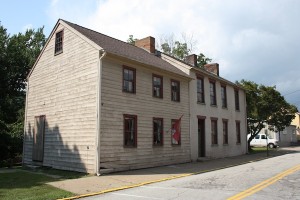 The Mon Valley Initiative (MVI) has donated a preservation easement to the Pittsburgh History & Landmarks Foundation to ensure the preservation and protection of the historic John C. Plumer House in West Newton, Pennsylvania, in Westmoreland County.
The Mon Valley Initiative (MVI) has donated a preservation easement to the Pittsburgh History & Landmarks Foundation to ensure the preservation and protection of the historic John C. Plumer House in West Newton, Pennsylvania, in Westmoreland County.Listed on the National Register of Historic Places in 1979, the original 2½-story frame house was completed in 1814 as the home of John Campbell Plumer and his new bride, Elizabeth Peaire. A brick addition was constructed in 1846.
A preservation easement is a voluntary legal agreement made between a property owner and a qualified preservation organization to protect the exterior of a historic site in perpetuity. It is recorded on the deed and filed in the Recorder of Deeds office. This easement would not have been possible without the partnership of a number of parties and a timely phone call.
“About a year ago, Ben Markle, president of the West Newton Historical Society, notified us that there was a possibility that the Plumer House might be demolished,” said PHLF President Arthur Ziegler. “When we contacted the Borough of West Newton, the owner of the property, we learned they were open to preserving the property if they could relinquish their ownership of it.”
Knowing how important the Plumer House could be to the economic revitalization of the Borough, PHLF began working with Downtown West Newton, Inc., a local non-profit group dedicated to the improvement of West Newton’s Main Street District. The organization already had a project underway with MVI. This project was a focused marketing initiative to promote the economic growth of West Newton.
These two organizations had local connections and a deep understanding of the community’s real estate market, which allowed for a strong partnership between all of the groups involved. Because of this, PHLF elected to work with MVI rather than accept a donation of the property.
“It couldn’t have worked out better,” says George Molovich, president of the West Newton Borough Council. “After learning more about preservation easements and reviewing our options, Council decided to convey the property to MVI on the condition that they donate and endow a preservation easement to PHLF and use the Plumer House to stimulate economic development.”
To help the process, PHLF deferred MVI’s contribution to endow annual monitoring costs to assure compliance with the terms of the easement and will assist MVI in marketing the Plumer House to a new owner.
“This undertaking is a wonderful example of what happens when there is an excellent relationship between an involved local Community Development Corporation, a supportive local government and strong non-profits,” says MVI Senior Real Estate Developer Patrick Shattuck. “A year ago, there was a chance that this one-of-a-kind property might be lost. Now, it is an important part of our strategic revitalization strategy for West Newton and is already attracting outside interest to this vibrant community.”
Under the easement terms, MVI and future Plumer House owners will continue to be responsible for the maintenance and upkeep of the house, and PHLF will be responsible for monitoring the property on at least an annual basis in perpetuity to assure compliance with the conditions of the easement. No changes can be made to the exterior of the building without PHLF’s prior approval and any changes should conform to the United States Secretary of the Interior’s Standards for Rehabilitation.
While granting a preservation easement on a historic property limits what an owner may do with the exterior of that property, granting the easement provides several benefits. The first and most obvious is that the property owner has protected the historic property in perpetuity from destruction, inappropriate alteration, or development of its land. Another is that an individual or corporate easement donor may be entitled to claim a federal charitable contribution tax deduction equal to the value of the preservation easement if certain conditions are met.
For example, without the federal charitable contribution deduction and rehabilitation tax credits associated with the restoration of historic properties, projects like the Bedford Springs Resort in Bedford, PA, and the Heinz Lofts and Armstrong Cork Factory Apartments in Pittsburgh, PA, might never have been developed. A charitable contribution deduction was not associated with the Plumer transaction, however, since the donor was a non-profit organization.
PHLF holds nearly 50 preservation easements and deed restrictions on Western Pennsylvania properties, and will announce another one on September 14 during its annual donor recognition event.
Pittsburgh History & Landmarks Foundation is a 501(c)(3) non-profit organization founded in 1964 whose mission is to identify and save historically significant places; revitalize historic neighborhoods; preserve historic farms and historic designed landscapes; and educate people about the Pittsburgh region’s rich architectural heritage. More information can be found at www.phlf.org.
The Mon Valley Initiative is a non-profit community and economic development coalition currently comprised of 10 Community Development Corporations whose mission is to work together to unite communities and restore the economic vitality of the Mon Valley. Downtown West Newton, Inc., is one of the member CDCs. More information can be found at www.monvalleyinitiative.com.
HISTORIC SIGNIFICANCE OF THE PROPERTY
Born in 1788, John C. Plumer was an important pioneer who spent the early part of his life trading in commodities necessary to frontier life. Upon his return from serving in the War of 1812, he was elected captain of a troop of Pennsylvania militia cavalry raised in Fayette and Westmoreland Counties and served a term of seven years.
He was active in many phases of community life. He bought a gristmill and saw mill from his brother and grew the business into one of the largest in the area. He also purchased a mill on Sewickley Creek and built a dam across the Youghiogheny River to furnish the power. Navigation was kept open by means of a lock. When a toll bridge was built to replace the ferry at nearby West Newton, Plumer supervised its construction and was a principal stockholder.
A follower of Andrew Jackson, Plumer was elected to the State Legislature in 1830 and the State Senate in 1839. Locally, he served as a Justice of the Peace and pioneered the movement for a free school system. Retiring from business in 1866, he died July 18, 1873.
-
Preservationists Praise Rehab Plan for Old Morgue
By Craig Smith, PITTSBURGH TRIBUNE-REVIEW
Friday, March 11, 2011http://www.pittsburghlive.com/x/pittsburghtrib/lifestyles/s_726879.html
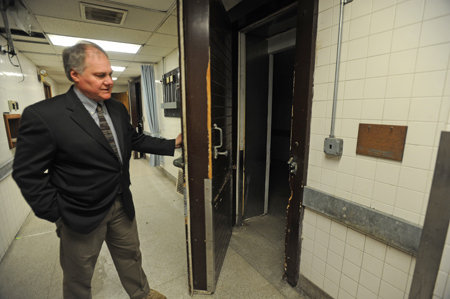
Sam Taylor, principal architect/building manager for Allegheny County department of public works, gives a tour of the old Allegheny County Morgue before it undergoes a $4 million renovation. James Knox | Tribune-Review
As a 14-year-old growing up in Oakland, Sam Taylor went to the Allegheny County Morgue at the urging of his friends to see the bodies on display.
It was a tradition for generations of Pittsburgh teens, he said. Some even took their prom dates.
“When you’re 14, you think you’re invincible,” said Taylor, 59, of Mt. Lebanon. “There was this yellowish light, and the bodies were kind of leaned back.”
Taylor, the county’s principal architect/building manager, is overseeing a $4 million renovation of the former morgue. The building, completed in 1903, was moved the length of a football field in 1929 to make way for the County Office Building.
Allegheny County expects to seek bids for demolition inside the building in late April or early May. That will create an additional 30,000 square feet of office space, while preserving many of the building’s unique features. The plan is to reuse transoms, stair railings and courtroom banisters, Taylor said.
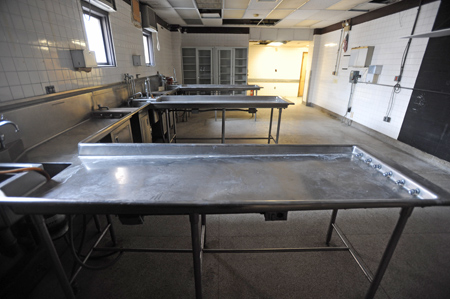
The autopsy room inside the old Allegheny County Morgue will be transformed into a new use. James Knox | Tribune-Review
A $900,000 project that included installing a terra cotta roof and masonry work was completed in 2006.
Officials haven’t determined who will use the space.
“We have a number of departments using leased space, including the Law Department and Economic Development,” said county spokesman Kevin Evanto.
Architect Paul Apostolou, who made a trip to the morgue when he was in high school, said a big part of the project will be undoing the “sledgehammer and hacksaw” approach to renovations over the years.
Preservationists praise the effort.
“I think they are trying to treat it very well for a building that no longer suits its original purpose because of modern technology,” said Arthur Ziegler, president of Pittsburgh History & Landmarks Foundation. “It’s a notable building in the government complex.”
The city designated the Frederick Osterling-designed building as a Pittsburgh landmark in 2002. Osterling, one of Pittsburgh’s premier architects, designed the county jail expansion of 1904 and Union Arcade (1915-17), which became Two Mellon Bank.
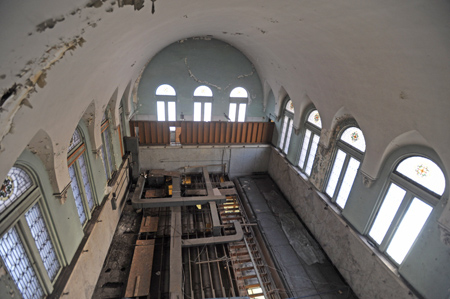
The "chapel" of the vacant old Allegheny County Morgue Friday was a place of prayer in a somber place. James Knox | Tribune-Review
The morgue building was designed to visually match the jail and courthouse, but by 1929, county government needed more space, according to a history of the building compiled by History & Landmarks. Officials decided a consolidated office building on Ross Street between Forbes and Fourth avenues would be the most efficient. That forced them to relocate the morgue.
The move was an enormous undertaking that took about three months. Work inside the building by the coroner and his staff continued without interruption, though. Temporary gas, water and sewer lines were connected and maintained on a 24-hour basis.
Huge timberwork and steel rails were used to move the building, which had to be lifted to the same height at the same moment. That ticklish maneuver was carried out by 100 men from a Balkan tribe — specialists in moving buildings from the “old country.”
They manned screw jacks that they gave a quarter turn every time a whistle sounded, until the three-story building was 27 feet in the air. It then was moved onto a system of beams designed by Kress-Oravetz Co. and slowly, laboriously pulled by cable to the foundation at 542 Fourth Ave.
Once there, Taylor said, they had to “shoehorn” the building between two structures.
In 2005, voters approved a referendum that eliminated the coroner as a row office, returning it to its early roots as an appointed position, now called medical examiner. The medical examiner’s office relocated in 2009 to a building in the Strip District.

